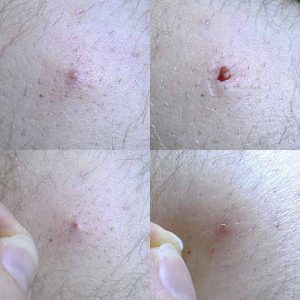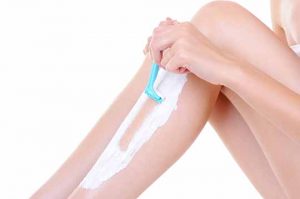Table of Contents
Overview
Ingrown hair can turn into a hard lump under the skin. Ingrown hair can also form cysts and sacs filled with fluid under the skin.
Ingrown hair lump can occur in any area with hair but mostly occurs in ingrown pubic hair.
Ingrown hair lumps usually do not cause any trouble and go away automatically over time. Still, if the lump causes an infection, irritation, or further problem, the doctor may drain it with a small incision.
Read this entire article to know all about ingrown hair turned into hard lump under skin.
What is Ingrown Pubic Hair Lump or Cyst?
Ingrown hair is more likely to grow underneath the skin rather than out of the skin. It can occur due to shaving, waxing, pulling of hair.
Curly hair can grow naturally beneath the skin. Other hair types people can also experience this.
Ingrown hair lump starts with a reddish swelling or bumps and ends up creating a fluid-filled sac underneath the skin.
Ingrown hair lump occurs mostly in the area of shaving or waxing, especially in pubic hair.
Common Area of Ingrown Hair Cyst
- armpits
- face
- head
- neck
- legs
- pubic region
Read Laser Hair Removal
Ingrown Hair Lumps or Cysts Symptoms
An ingrown hair lump occurs underneath the skin. It is often visible with a head that may turn red, yellow, or white in appearance.
The lump or cyst can be painful and tender while touching.
The lump appears as a small red bump over the skin. Most people know it as a razor bump. The medical term for ingrown hair lump is pseudofolliculitis.
The lump can grow over time and form a fluid-filled cyst.
It usually occurs in the area of hair shaving, such as the pubic area.

Some other signs may include;
- A mole that changed its shape and color recently
- Signs of irritation on the skin
- Red color patches on the skin
- The skin is peeling out
- Visible cyst with no clear border
- Painful ingrown hair cyst with a bacterial infection
- Dry skin with small bumps
Read Chymoral Forte – an OTC pain killer
Read Vitamin C For Skin Whitening
Ingrown hair lump (cyst) Causes
Hair follicles (the root of the hair) grow underneath the skin while hair strands grow outside.
When someone shaves, they only remove the strands of the hair, and the follicles remain intact underneath the skin. The same goes for waxing.
The shaved hair strand may grow inside the skin rather than outside and form a lump.

Skin cells, infectious fluid, keratin can be collected within the lump and form a cyst.
Ingrown hair cysts occur mainly in the hair shaving areas because shaving or waxing interrupt the natural hair growth process.
Read Masturbation Side Effects
Ingrown Hair Cyst Removal
Ingrown hair cysts and a lump can be dangerous if left untreated. Infection of the hair cyst is a common complication. It can leave a permanent scar on the area of the cyst.
It becomes more dangerous if the cyst occurs in your facial region.
If you are confused about the condition and notice any sign of infection you should visit a dermatologist as early as possible.
The ingrown hair cyst removal process at the dermatologist chamber is quick and easy. The doctor use some sterile instruments and make a quick small incision and remove the cyst. It does not leave any scar and is a minimally invasive procedure.
Ingrown Hair Cyst Removal At Home
- Clean the cyst or lump area with warm water during shower
- Avoid shaving near the cyst; it can cause and spread infections.
- Applying a warm compress to the area multiple times a day is helpful. It’ll let the entrapped hair grow out, and the cyst comes out of the skin.
- The local antiseptic solutions help to prevent infection.
Treatment Procedure
- The ingrown hair turned into a hard lump is not dangerous. Usually, it goes away on its own.
- Sometimes it gets infectious and causes pain and irritation. In that case, the doctor (dermatologist) drains the cyst by creating a small incision.
- Certain cream and injections are often used to reduce inflammation and irritation. These cream also helps to reduce the lump or cyst.
- If the cyst is infected and inflamed, then the doctor may prescribe you some antibiotics.
- Sometimes the dermatologist uses a needle to drain the cyst and enhance the healing process.
Triggering Factors
Itching, picking, or squeezing the area of a lump or cyst can cause infection. Do not touch the cyst or lump even if it itches.
When To Visit The Doctor
Few signs indicate you should visit a doctor. These signs may include;
- Area of ingrown hair lump is red, painful, itching, and swollen
- You have other associated medical conditions such as fever along with the ingrown hair cyst or lump
- The ingrown hair cysts occur very often
- You have injured the area by itching, picking, or squeezing
- Pus secretion from the cyst
- Bad odor from the cyst
Ingrown Hair Cyst Prevention
As the ingrown hair cyst occurs mostly in the area of shaving, the principal prevention method is to avoid shaving and waxing.
Use shaving gel or foam and warm water before shaving to prevent ingrown hair cyst
Other methods of prevention may include;
- Apply warm water in the area before shaving
- Use shaving gel or foam of good brands
- Avoid multiple strokes of razer
- Rinse the razor with warm water after each stroke
- Try not to shave every day
- Shave in the direction of hair growth
- Avoid using blunt razors
- Replace your razor at least once every six weeks
- After shaving, apply cold water into your skin and aftershave
- Rinse your face with a wet towel
- Use exfoliating body scrub if you notice any trapped hair
- Avoid shaving on irritated skin or area.
Ingrown Hair Cyst Risk Factors
- Shaving and waxing remove the hair part above the skin, and the follicles remain intact with a sharp edge of hair inside the skin, which allows the hair to grow easily beneath the skin.
- Dry skin can accumulate over the hair follicle and causes the hair to grow underneath the skin.
- Pressure on a hairy area can also cause an ingrown hair cyst.
- Persons with curly and coarse hair are more likely to experience ingrown hair lumps.
Takeaway
Ingrown hair lump or cyst develops in the area where the hair strand grows underneath the skin instead of over the skin.
Ingrown hair cysts can be small to large. They are not dangerous but can cause severe pain if they get infected.
Usually, ingrown hair cysts go away on their own. Still, if it’s painful and you visit a doctor, the doctor may drain it with a small incision.
There are some prevention methods of ingrown hair cysts. You should follow them to avoid it.
Frequently Asked Questions (FAQs)
Ingrown hair lump how long does it take to go away?
Ingrown hair lump usually goes away on its own within 1-2 weeks. If it’s not healing then consult a dermatologist, he’ll make an incision and clear the cyst.
How to treat ingrown hair lumps?
Ingrown hair lumps usually get cured all by themselves and fade away. If you notice any sign of infection there, consult a doctor.
I just removed ingrown hair. how long will it take for the lump to heal?
It will take a maximum of one week to heal the spot. If there was an infection then the time may vary.
Last Updated on April 9, 2022 by Learn From Doctor Team






